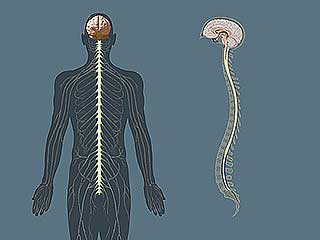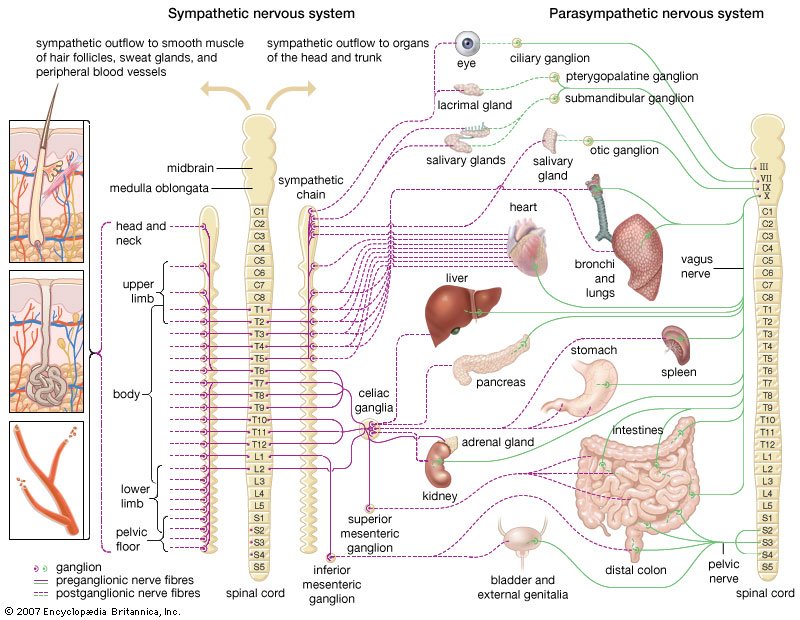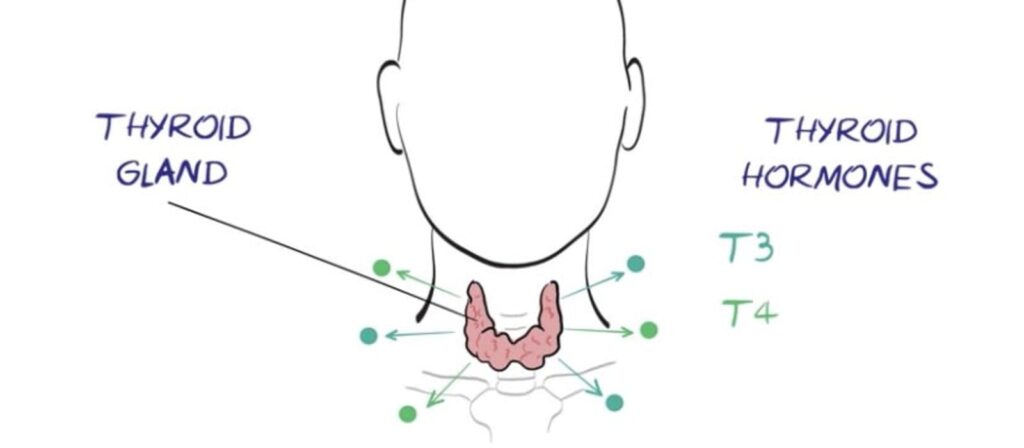Potential Causes of Fibromyalgia
There is unquestionable evidence from brain imaging and other techniques that fibromyalgia has strong biological foundations. Although, psychological, social, and behavioural factors clearly play prominent roles in some patients. 10. However, the causes of fibromyalgia largely remain a mystery. Scientific research over the last number of years has come up with a few different theories and hypotheses but none are proven definitive so far. A hypothesis is an idea or explanation for something that is based on known facts but is so far unproven. I discuss the main current hypotheses below.
What Causes Fibromyalgia – A Nervous System Disorder?
Central Nervous System
Firstly, the most widely accepted hypothesis is that fibromyalgia is caused by a central nervous system disorder. The central nervous system consists of the brain and spinal cord (see Figure 1). The theory is that fibromyalgia patients have a sensitised or hyperactive central nervous system, which leads to an increased amplification or “volume control” of pain and sensory processing. 11. So, according to this hypothesis, fibromyalgia patients have increased pain and sensory processing in the brain. This happens as a result of an increase in the number of connections to areas of the brain that perceive pain; and a decrease in the number of connections to areas of the brain that block the sensation of pain. 12. In other words, a fibromyalgia patient feels greater pain due to the brain’s wiring; with areas that perceive pain are turned up and areas that block pain are turned down.

Figure 1: Showing CNS (Brain and spinal cord) and associated peripheral nerves from https://media1.britannica.com/eb-media/89/143189-049-1F78073D.jpg Accessed July 2021.
Autonomic Nervous System
Secondly, an alternative hypothesis involves the autonomic nervous system. Fibromyalgia is a stress-related disorder; psychological and other types of stressors are often involved in the development and continuation of the illness. The sympathetic nervous system shown in figure 2 below, is the branch of the autonomic nervous system that regulates involuntary body functions. Therefore, it plays a key element of the body’s stress response system.
Consequently, another proposed hypothesis is that the cause of fibromyalgia is a dysfunction of the autonomic nervous system with additional neuropathic (nerve) pain features. 11. Neuropathic pain is a common symptom in fibromyalgia patients. Nerve disease is normally the cause of neuropathic pain, but it can also occur as the result of injury or infection. The discovery that a large group of fibromyalgia patients have a condition called “small fibre neuropathy”, reinforces this sympathetic nervous system hypothesis and also proves fibromyalgia pain. 12.

Figure 2: Showing the sympathetic and parasympathetic branches of the Autonomic Nervous System from https://www.britannica.com/science/autonomic-nervous-system Accessed July 2021
What Causes Fibromyalgia – An Autoimmune Disorder?
Thirdly, another alternative hypothesis is that an autoimmune disorder is the cause of fibromyalgia. Autoimmune disorders occur when the body’s immune cells attack the body’s own cells in the same way as they attack intruders, such as bacteria and viruses that would cause damage. Research over the years suggests this hypothesis could be true. Researchers discovered that a group of young women with widespread pain and small nerve neuropathy, also had blood serum markers that showed they had faulty immunity. 12. The researchers also found that these young people with autoimmune neuropathic fibromyalgia showed a good response to corticosteroids and immunoglobulin therapy.
Recent Research
A recent study adds weight to this autoimmune hypothesis. Researchers found that mice treated with purified antibodies taken from fibromyalgia patients displayed sensory hypersensitivities, typical of fibromyalgia symptoms. While, mice treated with antibodies from healthy subjects showed no sensory hypersensitivities. 13. The researchers found that the transfer of hypersensitivities from patients to mice was similar across all tested fibromyalgia patients from two different countries.
Consequently, this strongly suggests that the characteristic tenderness and thermal hypersensitivities experienced by fibromyalgia patients are antibody-dependent. Future research should determine which factors the symptom-inducing antibodies bind to; and could result in the development of new treatment strategies for fibromyalgia. Researchers believe that this could also lead to the development of a much-needed blood-based test for easier diagnosis.
What Causes Fibromyalgia – Hypothyroidism (Underactive Thyroid)?
Finally, another hypothesis is that hypothyroidism and cellular resistance to thyroid hormone is the cause of fibromyalgia. The thyroid gland has a butterfly shape and sits in the front of your neck, just below your Adam’s apple (see Figure 3). The thyroid is responsible for producing the thyroid hormones thyroxine (T4) and liothyronine (T3) that are necessary for all the cells in the body to work properly. These hormones are responsible for regulating the body’s metabolism, defined as the physical and chemical bodily processes required to maintain life. T4 is the inactive form of the hormone and relies on the body converting it to the active form, T3.
Hypothyroidism occurs when the thyroid gland does not produce enough thyroid hormone or the body fails to effectively convert T4 to T3. Similar to fibromyalgia, hypothyroidism mainly affects women, and causes tiredness, feeling cold, weight gain, poor concentration, and depression. 14. These symptoms also occur when the thyroid produces enough thyroid hormone but the hormone is unable to enter the body’s cells at high enough levels (cellular resistance to thyroid hormone). Insufficient active thyroid hormone lowers the metabolism within the cell and as such, the body as a whole.

Figure 3: Thyroid gland from https://www.btf-thyroid.org/what-is-thyroid-disorder Date of Access: July 2021
Hypothyroidism and Fibromyalgia
Fibromyalgia and hypothyroidism share the same symptoms. Studies have shown that most hypothyroid patients or those with cellular resistance to thyroid hormone who have effective treatment with thyroid hormone replacement lose their fibromyalgia symptoms. 15. The authors, Nowicki and Lowe, reason that this indicates that these fibromyalgia patients are a distinct subset with symptoms being due to inadequate thyroid hormone tissue regulation. They also claim that this finding justifies a trial of thyroid hormone replacement therapy for fibromyalgia patients. This would determine if hypothyroidism or cellular resistance to thyroid hormone is the cause of their fibromyalgia symptoms.
Nowicki and Lowe also state that clinical trials found the only patients fully relieved of fibromyalgia symptoms had taken thyroid hormone orally, alongside additional metabolism-regulating therapies. The most common of these metabolism-regulating therapies that patients must use are a wholesome diet, nutritional supplementation, and exercise to tolerance (discussed later in the Managing the Symptoms section). Studies have shown that these therapies have improved the symptoms of fibromyalgia patients, and they note that these therapies are necessary for most patients to recover fully. However, in most cases, they are not sufficient without thyroid hormone therapy. 15.
Could all of these Hypotheses Be the Cause of Fibromyalgia?
In concluson, each of these hypotheses are valid, having scientific evidence to back them up. This would suggest that at least one of these hypotheses will be the cause of fibromyalgia for every fibromyalgia patient. The problem being, that there is no definitive test for fibromyalgia and that diagnosis is only made after all other diseases and conditions are ruled out. As a result, fibromyalgia is a catch-all, umbrella term to describe chronic pain symptoms that fit no other diagnosis. It’s not an exact science.
Due to having no definitive cause, there is no definitive cure. Finding the causes will allow researchers to develop definitive tests as well as potential cures. So, I suspect that future research will show that there are a number of different problems that cause fibromyalgia. Unfortunately, that’s not helpful for current fibromyalgia patients, who are left with more questions than answers. We therefore have to find our own solutions. In short, we need to find strategies that improve our symptoms, on a trial-and-error basis.
Next: Managing the Symptoms – EULAR recommendations
References
10. Ursini, F., Ciaffi, J., Mancarella, L., Lisi, L., Brusi, V., Cavallari, C., D’Onghia, M., Mari, A., Borlandelli, E., Cordella, J.F. and La Regina, M., 2021. Fibromyalgia: a new facet of the post-COVID-19 syndrome spectrum? Results from a web-based survey. RMD open, 7(3), p.e001735.
11. Clauw, D.J., 2015, May. Fibromyalgia and related conditions. In Mayo Clinic Proceedings (Vol. 90, No. 5, pp. 680-692). Elsevier.
12 Martínez-Lavín, M., 2018. Fibromyalgia and small fiber neuropathy: the plot thickens!. Clinical rheumatology, 37(12), pp.3167-3171.
13. Goebel, A., Krock, E., Gentry, C., Israel, M.R., Jurczak, A., Urbina, C.M., Sandor, K., Vastani, N., Maurer, M., Cuhadar, U. and Sensi, S., 2021. Passive transfer of fibromyalgia symptoms from patients to mice. Journal of Clinical Investigation, 131(13), p.e144201.
14. British Thyroid Foundation, 2021. Your Thyroid Gland. https://www.btf-thyroid.org/what-is-thyroid-disorder Accessed July 2021.
15. Nowicki, J. and Lowe, J.C., 2020. Fibromyalgia Syndrome. In Textbook of Natural Medicine (pp. 1319-1329). Churchill Livingstone.






